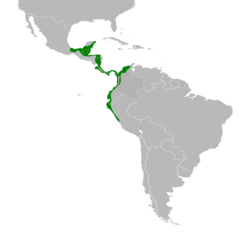Biology:White-browed gnatcatcher
| White-browed gnatcatcher | |
|---|---|

| |
| Preserved specimen at Naturalis Biodiversity Center | |
| Scientific classification | |
| Domain: | Eukaryota |
| Kingdom: | Animalia |
| Phylum: | Chordata |
| Class: | Aves |
| Order: | Passeriformes |
| Family: | Polioptilidae |
| Genus: | Polioptila |
| Species: | P. bilineata
|
| Binomial name | |
| Polioptila bilineata (Bonaparte, 1850)
| |

| |
The white-browed gnatcatcher (Polioptila bilineata) is a species of bird in the gnatcatcher family Polioptilidae. It is native to central and South America.
This species was formerly considered a subspecies of the tropical gnatcatcher (Polioptila plumbea).
Taxonomy
The white-browed gnatcatcher was formally described in 1850 by the French naturalist Charles Lucien Bonaparte and given the binomial name Sylvia bilineata. Bonaparte specified the locality as Cartagena, a city on the Caribbean coast of Colombia.[1][2] This species was formerly considered as a subspecies of the tropical gnatcatcher (Polioptila plumbea). The white-browed gnatcatcher was split from the tropical gnatcatcher based on morphology and phylogenetic data.[3][4][5]
Five subspecies are recognised:[4]
- Polioptila bilineata brodkorbi Parkes, 1979 – south Mexico to north Costa Rica
- Polioptila bilineata superciliaris Lawrence, 1861 – north-central Costa Rica to north Colombia
- Polioptila bilineata cinericia Wetmore, 1957 – Coiba (island off south Panama)
- Polioptila bilineata bilineata (Bonaparte, 1850) – northwest Colombia to northwest Peru
- Polioptila bilineata daguae Chapman, 1915 – west-central Colombia
References
- ↑ Bonaparte, Charles Lucien (1850) (in Latin). Conspectus Generum Avium. 1. Leiden: E.J. Brill. p. 316. https://www.biodiversitylibrary.org/page/43560479.
- ↑ Mayr, Ernst; Paynter, Raymond A. Jr, eds (1964). Check-list of Birds of the World. 10. Cambridge, Massachusetts: Museum of Comparative Zoology. p. 452. https://www.biodiversitylibrary.org/page/14486641.
- ↑ Smith, B.T.; Bryson, R.W. Jr; Mauck, W.M.; Chaves, J.; Robbins, M.B.; Aleixo, A.; Klicka, J. (2018). "Species delimitation and biogeography of the gnatcatchers and gnatwrens (Aves: Polioptilidae)". Molecular Phylogenetics and Evolution 126: 45–57. doi:10.1016/j.ympev.2018.03.012. https://www.biorxiv.org/content/biorxiv/early/2018/02/26/271494.full.pdf.
- ↑ 4.0 4.1 Gill, Frank; Donsker, David; Rasmussen, Pamela, eds (July 2021). "Dapple-throats, sugarbirds, fairy-bluebirds, kinglets, Elachura, hyliotas, wrens, gnatcatchers". IOC World Bird List Version 11.2. International Ornithologists' Union. https://www.worldbirdnames.org/bow/sugarbirds/.
- ↑ Chesser, R.T.; Billerman, S.M.; Burns, K.J.; Cicero, C.; Dunn, J.L.; Hernández-Baños, B.E.; Kratter, A.W.; Lovette, I.J. et al. (2021). "Sixty-second Supplement to the American Ornithological Society’s Check-list of North American Birds". Ornithology (ukab037). doi:10.1093/ornithology/ukab037.
Wikidata ☰ Q107486428 entry
 |

